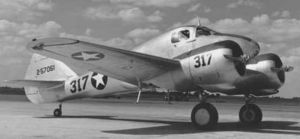PlaneSpottingWorld welcomes all new members! Please gives your ideas at the Terminal.
Curtiss AT-9
The Curtiss-Wright AT-9 Jeep was a twin-engined advanced trainer aircraft used by the United States during World War II to bridge the gap between single-engine trainers and twin-engine combat aircraft. The AT-9 was of a low-wing cantilever monoplane configuration, had retractable landing gear and was powered by two Lycoming R-680-9 radial engines.
Development
Curtiss-Wright anticipated the requirement for this type of plane and designed the Curtiss-Wright CW-25, a twin-engine trainer, which possessed the takeoff and landing characteristics of a light bomber aircraft.
Operational history
The first prototype flew in 1941 and the production version entered service as the AT-9 in 1942. Named the "Fledgling" by Curtiss-Wright, it commonly became known as the "Jeep" in the USAAC. The prototype CW-25 had a fabric-covered steel tube fuselage and fabric-covered wings, but production AT-9s were of stressed metal skin construction.
The AT-9 was not easy to fly or land, which made it particularly suitable for teaching new pilots to cope with the demanding flight characteristics of a new generation of high-performance, multi-engine aircraft such as the B-26 Marauder and P-38 Lightning. However, many pilots who have flown both the AT-9 and the P-38 have said that the Lightning should have been used to train people to fly the Jeep!
Four hundred ninety-one AT-9's were built before production ended in February 1943.
Because of its difficult flying characteristics the AT-9 was not offered for sale to civilians after the War, although many non-flying examples were given to ground schools for training purposes.
Survivors
Two AT-9's survive today. One AT-9A is on permanent display at the National Museum of the United States Air Force in Dayton, Ohio. While the wreckage of an AT-9A recovered from a crash site in 2003 was turned over to the Pima Air & Space Museum for restoration. The aircraft is incomplete and will require a long and extensive restoration for display.
Variants
- AT-9 : Twin-engined advanced training aircraft.
- AT-9A : Three hundred four-seater AT-9A's were built before production ended in February 1943.
Specifications (AT-9)
General characteristics
- Crew: two - student and instructor
- Length: 31 ft 8 in (9.65 m)
- Wingspan: 40 ft 4 in (12.29 m)
- Height: 9 ft 10 in (2.99 m)
- Wing area: 233 ft² (21.7 m²)
- Empty: 4,600 lb (2,087 kg)
- Loaded: 6,000 lb (2,722 kg)
- Maximum takeoff: 6,062 lb (2,755 kg)
- Powerplant: 2x Lycoming R-680-9, 295 hp (220 kW) each
Performance
- Maximum speed: 197 mph (123 km/h)
- Range: 750 miles (469 km)
- Service ceiling: 19,000 ft (5,793 m)
- Rate of climb: ft/min ( m/min)
- Wing loading: 26 lb/ft² (125 kg/m²)
- Power/Mass: 0.10 hp/lb (0.16 kW/kg)
External link
Related content
Related development:
Comparable aircraft: Beech C-45 Expeditor
Designation sequence: AT-6 - AT-7 - AT-8 - AT-9 - AT-10 - AT-11 - AT-12
Lists relating to aviation | |
|---|---|
| General | Timeline of aviation · Aircraft · Aircraft manufacturers · Aircraft engines · Aircraft engine manufacturers · Airports · Airlines |
| Military | Air forces · Aircraft weapons · Missiles · Unmanned aerial vehicles (UAVs) · Experimental aircraft |
| Notable incidents and accidents | Military aviation · Airliners · General aviation · Famous aviation-related deaths |
| Records | Flight airspeed record · Flight distance record · Flight altitude record · Flight endurance record · Most produced aircraft |


